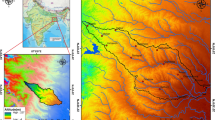Abstract
Forest vegetation of Vindhyan range located in the north of G.B. Pant Sagar (dam) has been subjected to degradation due to high biotic pressure caused by the installation of thermal power plants, coal mining, heavy cattle grazing etc. In the present study Landsat TM FCC of 1∶250,000 scale was visually analysed with respect to forest vegetation types, crown density and structure along with other landuse/land cover classes. ExceptShorea robusta (Sal) andLagerstroemia parviflora (Lendia) all forest vegetation types show higher percentage of degradation and under-stocked condition with respect to their areal extent under study. Overall classification accuracy of the forest types has been found to be 88.94%. This indicates that for obtaining reliable mapping accuracy in dry deciduous areas, satellite remote sensing data of appropriate season is essential.
Similar content being viewed by others
References
Anonymous (1986). Forest Mapping in Integrated Land Resources Survey for Potential Landuse Planning, using IRS-1A Simulated Data. Project Report, Indian Institute of Remote Sensing, Dehradun, 47–53 pp.
Bowden L W and Pruitt E L (1983).Manual of Remote Sensing, American Society of Photogrammetry, Falls Church, Virginia, z, 882–891 pp.
Champion H G and Seth S K (1968). Forest Types of India, Manager Publications, Government of India, Delhi.
Jha C S (1990). Analysis of Vegetation and landuse in Obra, Renukoot Singrauli area, Ph.D. Thesis, BHU, Varanasi.
Pant D N and Roy P S (1990). Vegetation and landuse analysis of Aglar Watershed using Satellite Remote Sensing Technique.Journal of the Indian Society of Remote Sensing, Vol. 18, No. 4, 1–14.
Roy P S, Kaul R N, Roy M R and Gabryal S S (1985). Forest Type Stratification and Delineation of Shifting Cultivation in the Eastern Part of Arunachal Pradesh using Landsat MSS Data.International Journal of Remote Sensing, 6 (3&4), 411–418.
Tiwari A K, Kudrat M and Bhan S K (1990). Vegetation Cover Classification in Sariska National Park and Surroundings,Journal of Indian Society of Remote Sensing, Vol. 18, No. 3, 43–51.
Unni N V M (1983). Forest Survey and Management using Remote Sensing. Edited by B.L. Deekshatulu & Y.S. Rajan. Ind. Acad. of Science, Bangalore, 115–133 pp.
Author information
Authors and Affiliations
About this article
Cite this article
Pant, D.N., Das, K.K. & Roy, P.S. Mapping of tropical dry deciduous forest and landuse in part of Vindhyan range using satellite remote sensing. J Indian Soc Remote Sens 20, 9–20 (1992). https://doi.org/10.1007/BF02991881
Received:
Accepted:
Issue Date:
DOI: https://doi.org/10.1007/BF02991881




